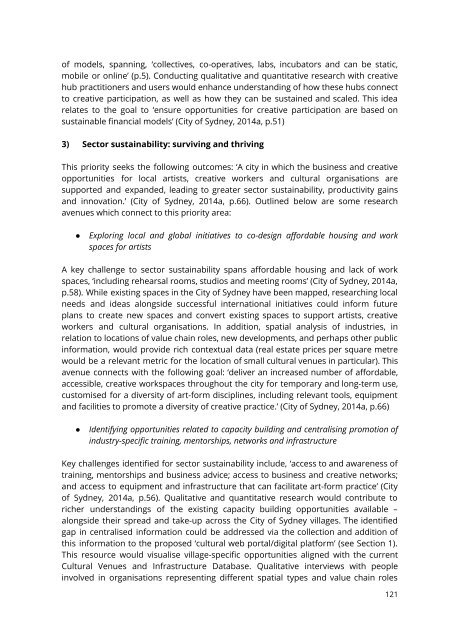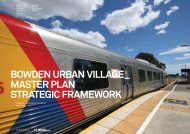MAPPING CULTURE
Mapping-Culture-Venues-and-Infrastructure-in-the-City-of-Sydney
Mapping-Culture-Venues-and-Infrastructure-in-the-City-of-Sydney
Create successful ePaper yourself
Turn your PDF publications into a flip-book with our unique Google optimized e-Paper software.
of models, spanning, ‘collectives, co-operatives, labs, incubators and can be static,<br />
mobile or online’ (p.5). Conducting qualitative and quantitative research with creative<br />
hub practitioners and users would enhance understanding of how these hubs connect<br />
to creative participation, as well as how they can be sustained and scaled. This idea<br />
relates to the goal to ‘ensure opportunities for creative participation are based on<br />
sustainable financial models’ (City of Sydney, 2014a, p.51)<br />
3) Sector sustainability: surviving and thriving<br />
This priority seeks the following outcomes: ‘A city in which the business and creative<br />
opportunities for local artists, creative workers and cultural organisations are<br />
supported and expanded, leading to greater sector sustainability, productivity gains<br />
and innovation.’ (City of Sydney, 2014a, p.66). Outlined below are some research<br />
avenues which connect to this priority area:<br />
●<br />
Exploring local and global initiatives to co-design a 齰〗 ordable housing and work<br />
spaces for artists<br />
A key challenge to sector sustainability spans affordable housing and lack of work<br />
spaces, ‘including rehearsal rooms, studios and meeting rooms’ (City of Sydney, 2014a,<br />
p.58). While existing spaces in the City of Sydney have been mapped, researching local<br />
needs and ideas alongside successful international initiatives could inform future<br />
plans to create new spaces and convert existing spaces to support artists, creative<br />
workers and cultural organisations. In addition, spatial analysis of industries, in<br />
relation to locations of value chain roles, new developments, and perhaps other public<br />
information, would provide rich contextual data (real estate prices per square metre<br />
would be a relevant metric for the location of small cultural venues in particular). This<br />
avenue connects with the following goal: ‘deliver an increased number of affordable,<br />
accessible, creative workspaces throughout the city for temporary and long-term use,<br />
customised for a diversity of art-form disciplines, including relevant tools, equipment<br />
and facilities to promote a diversity of creative practice.’ (City of Sydney, 2014a, p.66)<br />
●<br />
Identifying opportunities related to capacity building and centralising promotion of<br />
industry-speci 秜ᇘ c training, mentorships, networks and infrastructure<br />
Key challenges identified for sector sustainability include, ‘access to and awareness of<br />
training, mentorships and business advice; access to business and creative networks;<br />
and access to equipment and infrastructure that can facilitate art-form practice’ (City<br />
of Sydney, 2014a, p.56). Qualitative and quantitative research would contribute to<br />
richer understandings of the existing capacity building opportunities available –<br />
alongside their spread and take-up across the City of Sydney villages. The identified<br />
gap in centralised information could be addressed via the collection and addition of<br />
this information to the proposed ‘cultural web portal/digital platform’ (see Section 1).<br />
This resource would visualise village-specific opportunities aligned with the current<br />
Cultural Venues and Infrastructure Database. Qualitative interviews with people<br />
involved in organisations representing different spatial types and value chain roles<br />
121



